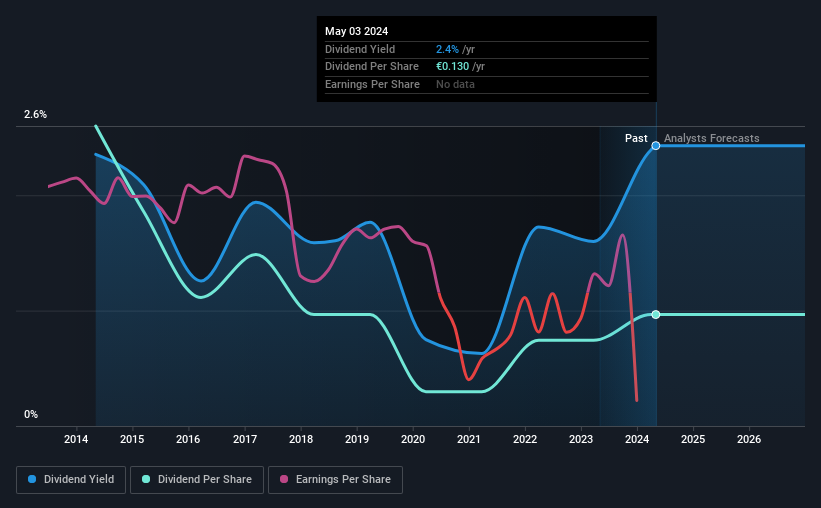We Wouldn't Be Too Quick To Buy Softing AG (ETR:SYT) Before It Goes Ex-Dividend
Readers hoping to buy Softing AG (ETR:SYT) for its dividend will need to make their move shortly, as the stock is about to trade ex-dividend. The ex-dividend date is usually set to be one business day before the record date which is the cut-off date on which you must be present on the company's books as a shareholder in order to receive the dividend. The ex-dividend date is important as the process of settlement involves two full business days. So if you miss that date, you would not show up on the company's books on the record date. In other words, investors can purchase Softing's shares before the 9th of May in order to be eligible for the dividend, which will be paid on the 13th of May.
The company's next dividend payment will be €0.13 per share, on the back of last year when the company paid a total of €0.13 to shareholders. Looking at the last 12 months of distributions, Softing has a trailing yield of approximately 2.4% on its current stock price of €5.35. Dividends are an important source of income to many shareholders, but the health of the business is crucial to maintaining those dividends. That's why we should always check whether the dividend payments appear sustainable, and if the company is growing.
See our latest analysis for Softing
Dividends are typically paid out of company income, so if a company pays out more than it earned, its dividend is usually at a higher risk of being cut. Softing paid a dividend last year despite being unprofitable. This might be a one-off event, but it's not a sustainable state of affairs in the long run. Given that the company reported a loss last year, we now need to see if it generated enough free cash flow to fund the dividend. If cash earnings don't cover the dividend, the company would have to pay dividends out of cash in the bank, or by borrowing money, neither of which is long-term sustainable. The company paid out 100% of its free cash flow over the last year, which we think is outside the ideal range for most businesses. Companies usually need cash more than they need earnings - expenses don't pay themselves - so it's not great to see it paying out so much of its cash flow.
Click here to see how much of its profit Softing paid out over the last 12 months.
Have Earnings And Dividends Been Growing?
When earnings decline, dividend companies become much harder to analyse and own safely. If earnings fall far enough, the company could be forced to cut its dividend. Softing reported a loss last year, and the general trend suggests its earnings have also been declining in recent years, making us wonder if the dividend is at risk.
The main way most investors will assess a company's dividend prospects is by checking the historical rate of dividend growth. Softing has seen its dividend decline 9.4% per annum on average over the past 10 years, which is not great to see. It's never nice to see earnings and dividends falling, but at least management has cut the dividend rather than potentially risk the company's health in an attempt to maintain it.
We update our analysis on Softing every 24 hours, so you can always get the latest insights on its financial health, here.
The Bottom Line
Is Softing worth buying for its dividend? It's hard to get used to Softing paying a dividend despite reporting a loss over the past year. Worse, the dividend was not well covered by cash flow. Bottom line: Softing has some unfortunate characteristics that we think could lead to sub-optimal outcomes for dividend investors.
Having said that, if you're looking at this stock without much concern for the dividend, you should still be familiar of the risks involved with Softing. To help with this, we've discovered 2 warning signs for Softing (1 is potentially serious!) that you ought to be aware of before buying the shares.
Generally, we wouldn't recommend just buying the first dividend stock you see. Here's a curated list of interesting stocks that are strong dividend payers.
Have feedback on this article? Concerned about the content? Get in touch with us directly. Alternatively, email editorial-team (at) simplywallst.com.
This article by Simply Wall St is general in nature. We provide commentary based on historical data and analyst forecasts only using an unbiased methodology and our articles are not intended to be financial advice. It does not constitute a recommendation to buy or sell any stock, and does not take account of your objectives, or your financial situation. We aim to bring you long-term focused analysis driven by fundamental data. Note that our analysis may not factor in the latest price-sensitive company announcements or qualitative material. Simply Wall St has no position in any stocks mentioned.

 Yahoo Finance
Yahoo Finance 
